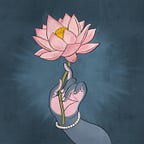Marāṭha school of Tanjāvur
Patronage for the Mysore school of art was revived by the Wodayars, when they were restored to power by the British following their defeat of Tipu Sultan and his resulting death in the battle of Srirangapatnam. It was seen as more a continuation of the earlier Nāyaka phase in this region, and which was interrupted under Tipu’s reign. The school closely resembles in several respects the Maratha school of Tanjāvur, of which almost the last and the greatest patron was Serfoji who lived in the early 19th century. A portrait of Serfoji (Sarabhoji II Bhonsle) of Tanjāvur is found in a Navanītakṛṣṇa painting at the National Museum, New Delhi, where humbly at the feet of the large-proportioned baby Kṛṣṇa is the prince, shown in the characteristic royal costume and turban of the day, his hands brought together in añjali.
This is a very fine and detailed painting, which incorporates the best elements of this school. During the time of the Marathas in the south, there was great encouragement of all the kaḷas or arts, including music, dance, painting, sculpture, literary composition, and every conceivable art and craft. Tanjāvur and Kumbakonam became great centres of this mode of painting with certain unique Maharashtrian touches introduced in what continued to be mainly the local Nāyaka style. Vijayanagara idiom could still be seen, though in a peculiarly transformed form, which, from the middle of the 18th century, continued for nearly a century more. In this there is an emphasis laid on pure colors, avoiding mixing, but with slight, stylised modelling effected by shading the inside of the contour. The principal colours are red, yellow, blue, black and white, all of them pure and untinged. Jewels, drapery and architectural elements, like pillars and canopy, are slightly raised, as in low relief, by the use of a special paste made of fine sawdust and glue, carefully modelled and covered with gold leaf, after fixing in it semi-precious stones of different hues. This is a noteworthy characteristic of the Tanjāvur school.
The principal figure is very often of larger size than the rest, and in spite of the best representation of portraiture as in several picture of the rulers and noblemen, a special type of stylisation is apparent.
Describing the city a British officer, Hemingway, writing in 1906, states: “Tanjore was known as the home of the fine arts under the native rulers who by their patronage attracted to their capital the producers of most articles of luxury. This reputation still survives though in a much modified degree. The Tanjore brass- work is deservedly famous and its ornamental pith work and musical instruments are said to be unique.” Hemingway also reported that “There are still a number of families who live by painting — indeed, one of the things that strikes the eye of any visitor to the town is the number of walls of houses and temples on which figures are not inartistically drawn and painted. The silk weaving is said to employ some 800 households and the quality of the work is unusually good. The town contains many other more usual and smaller industries and is, of course, the centre of a great deal of trade.”
It is not surprising therefore, that the art of Tanjavur is very closely related to its crafts. The sacred icon paintings are related on the one hand to carved and painted wood and on the other to jewellery with its stone setting and gilding. Painting on a variety of other materials such as ivory, glass, and mica was in vogue. Historians also record a brisk internal trade and mention the existence of guilds of merchants. Spinning and weaving formed a highly sophisticated and major industry until the loss of the trade due to the British in the 18th and 19th centuries. Nilakanta Shastri states, “All the arts and crafts were organised in castes and according to established tradition: we do not get the names even of the talented architects, sculptors and painters in most instances.” This was in keeping with the non-individualistic styles and method of work prevalent from ancient times.
Taken from: Vijayanagara Painting by C. Sivaramamurti
Tanjavur Painting of the Maratha Period Volume 1, Jaya Appasamy
__________________________________________
If you find value in my work, I hope you consider becoming a patron or making a contribution to hindu.aesthetic@okicici. Hindu Aesthetic requires a lot of time and effort and your support would mean that I can continue bringing you the best possible content. ❤
